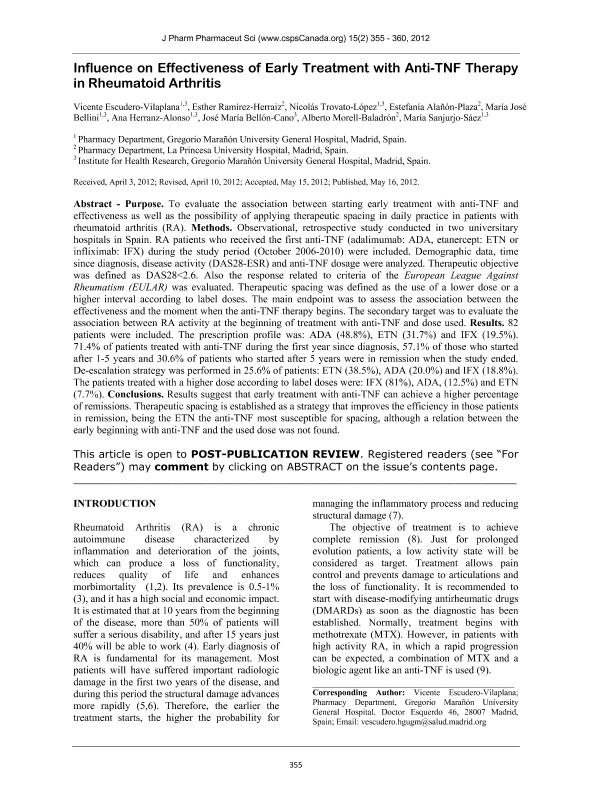Mostrar el registro sencillo del ítem
dc.contributor.author
Escudero-Vilaplana, Vicente
dc.contributor.author
Ramírez-Herraiz, Esther
dc.contributor.author
Trovato-López, Nicolás
dc.contributor.author
Alañón-Plaza, Estefania
dc.contributor.author
Bellini, Maria Jose

dc.contributor.author
Herranz-Alonso, Ana
dc.contributor.author
Bellón-Cano, José María
dc.contributor.author
Morell-Baladrón, Alberto
dc.contributor.author
Sanjurjo-Sáez, María
dc.date.available
2019-08-20T19:54:01Z
dc.date.issued
2012-05-16
dc.identifier.citation
Escudero-Vilaplana, Vicente; Ramírez-Herraiz, Esther; Trovato-López, Nicolás; Alañón-Plaza, Estefania; Bellini, Maria Jose; et al.; Influence on effectiveness of early treatment with anti-TNF therapy in rheumatoid arthritis; Canadian Society for Pharmaceutical Sciences; Journal of Pharmacy and Pharmaceutical Sciences; 15; 3; 16-5-2012; 355-360
dc.identifier.issn
1482-1826
dc.identifier.uri
http://hdl.handle.net/11336/81865
dc.description.abstract
Purpose. To evaluate the association between starting early treatment with anti-TNF and effectiveness as well as the possibility of applying therapeutic spacing in daily practice in patients with rheumatoid arthritis (RA). Methods. Observational, retrospective study conducted in two universitary hospitals in Spain. RA patients who received the first anti-TNF (adalimumab: ADA, etanercept: ETN or infliximab: IFX) during the study period (October 2006-2010) were included. Demographic data, time since diagnosis, disease activity (DAS28-ESR) and anti-TNF dosage were analyzed. Therapeutic objective was defined as DAS28<2.6. Also the response related to criteria of the European League Against Rheumatism (EULAR) was evaluated. Therapeutic spacing was defined as the use of a lower dose or a higher interval according to label doses. The main endpoint was to assess the association between the effectiveness and the moment when the anti-TNF therapy begins. The secondary target was to evaluate the association between RA activity at the beginning of treatment with anti-TNF and dose used. Results. 82 patients were included. The prescription profile was: ADA (48.8%), ETN (31.7%) and IFX (19.5%). 71.4% of patients treated with anti-TNF during the first year since diagnosis, 57.1% of those who started after 1-5 years and 30.6% of patients who started after 5 years were in remission when the study ended. De-escalation strategy was performed in 25.6% of patients: ETN (38.5%), ADA (20.0%) and IFX (18.8%). The patients treated with a higher dose according to label doses were: IFX (81%), ADA, (12.5%) and ETN (7.7%). Conclusions. Results suggest that early treatment with anti-TNF can achieve a higher percentage of remissions. Therapeutic spacing is established as a strategy that improves the efficiency in those patients in remission, being the ETN the anti-TNF most susceptible for spacing, although a relation between the early beginning with anti-TNF and the used dose was not found.
dc.format
application/pdf
dc.language.iso
eng
dc.publisher
Canadian Society for Pharmaceutical Sciences

dc.rights
info:eu-repo/semantics/openAccess
dc.rights.uri
https://creativecommons.org/licenses/by-nc/2.5/ar/
dc.subject
Rheumatoid Arthritis
dc.subject
Anti-Tnf
dc.subject.classification
Farmacología y Farmacia

dc.subject.classification
Medicina Básica

dc.subject.classification
CIENCIAS MÉDICAS Y DE LA SALUD

dc.title
Influence on effectiveness of early treatment with anti-TNF therapy in rheumatoid arthritis
dc.type
info:eu-repo/semantics/article
dc.type
info:ar-repo/semantics/artículo
dc.type
info:eu-repo/semantics/publishedVersion
dc.date.updated
2019-05-03T17:36:47Z
dc.journal.volume
15
dc.journal.number
3
dc.journal.pagination
355-360
dc.journal.pais
Canadá

dc.description.fil
Fil: Escudero-Vilaplana, Vicente. Gregorio Marañon University General Hospital. Pharmacy Department; España
dc.description.fil
Fil: Ramírez-Herraiz, Esther. La Princesa University Hospital. Pharmacy Department; España
dc.description.fil
Fil: Trovato-López, Nicolás. Gregorio Marañon University General Hospital. Pharmacy Department; España. Gregorio Marañon University General Hospital. Institute for Health Research; España
dc.description.fil
Fil: Alañón-Plaza, Estefania. La Princesa University Hospital. Pharmacy Department; España
dc.description.fil
Fil: Bellini, Maria Jose. Consejo Nacional de Investigaciones Científicas y Técnicas. Centro Científico Tecnológico Conicet - La Plata. Instituto de Investigaciones Bioquímicas de La Plata "Prof. Dr. Rodolfo R. Brenner". Universidad Nacional de la Plata. Facultad de Ciencias Médicas. Instituto de Investigaciones Bioquímicas de La Plata "Prof. Dr. Rodolfo R. Brenner"; Argentina. Gregorio Marañon University General Hospital. Pharmacy Department; España. La Princesa University Hospital. Pharmacy Department; España
dc.description.fil
Fil: Herranz-Alonso, Ana. Gregorio Marañon University General Hospital. Institute for Health Research; España. Gregorio Marañon University General Hospital. Pharmacy Department; España
dc.description.fil
Fil: Bellón-Cano, José María. Gregorio Marañon University General Hospital. Institute for Health Research; España
dc.description.fil
Fil: Morell-Baladrón, Alberto. La Princesa University Hospital. Pharmacy Department; España
dc.description.fil
Fil: Sanjurjo-Sáez, María. Gregorio Marañon University General Hospital. Pharmacy Department; España. Gregorio Marañon University General Hospital. Institute for Health Research; España
dc.journal.title
Journal of Pharmacy and Pharmaceutical Sciences

dc.relation.alternativeid
info:eu-repo/semantics/altIdentifier/url/http://ejournals.library.ualberta.ca/index.php/JPPS/article/view/17022
dc.relation.alternativeid
info:eu-repo/semantics/altIdentifier/doi/http://dx.doi.org/10.18433/J33W30
Archivos asociados
